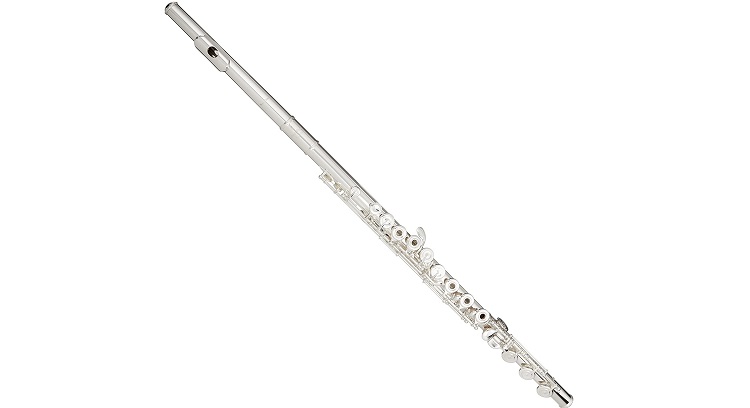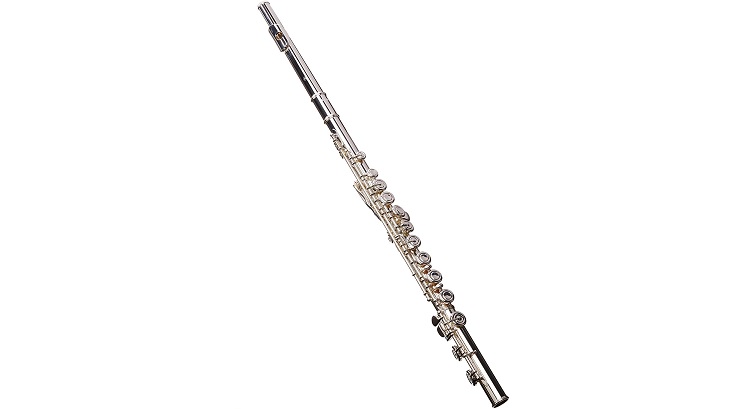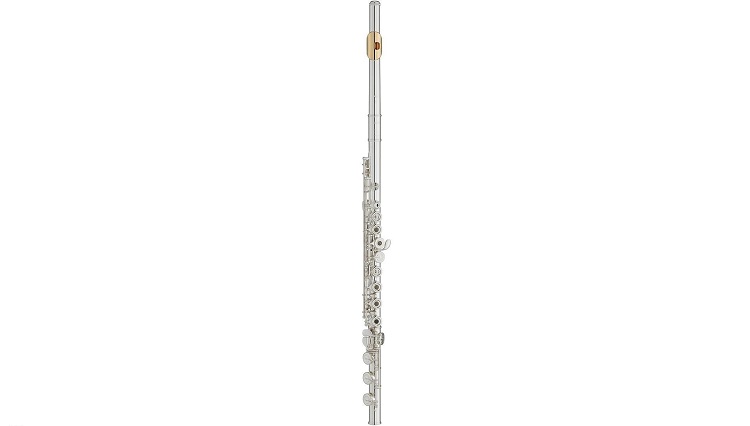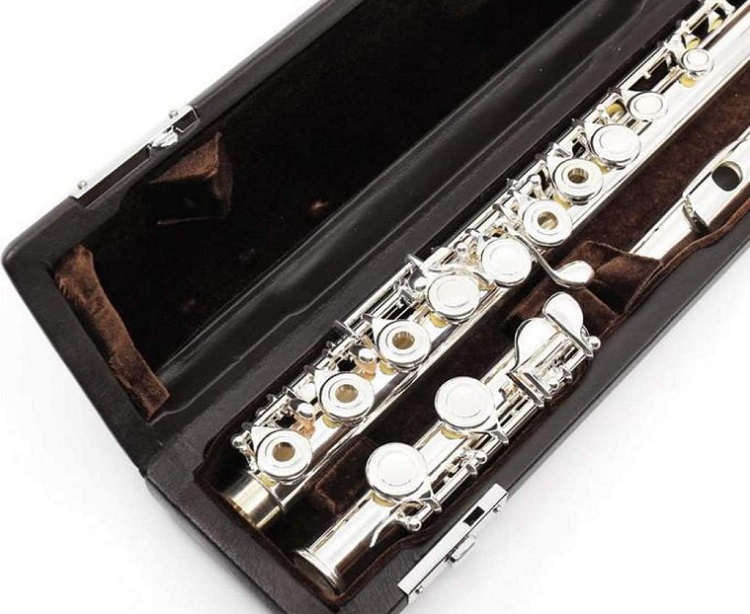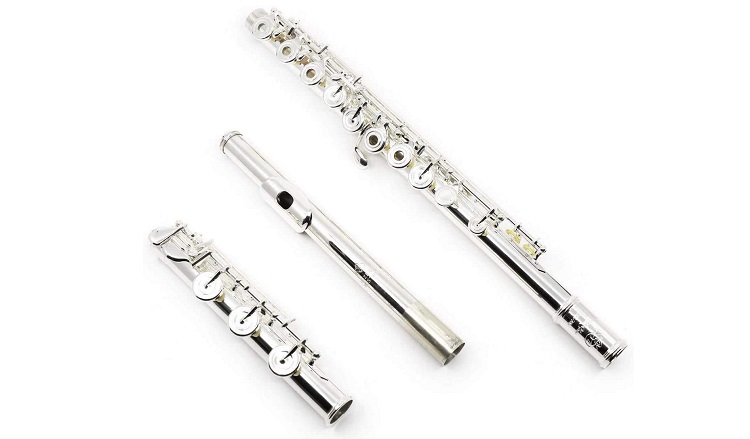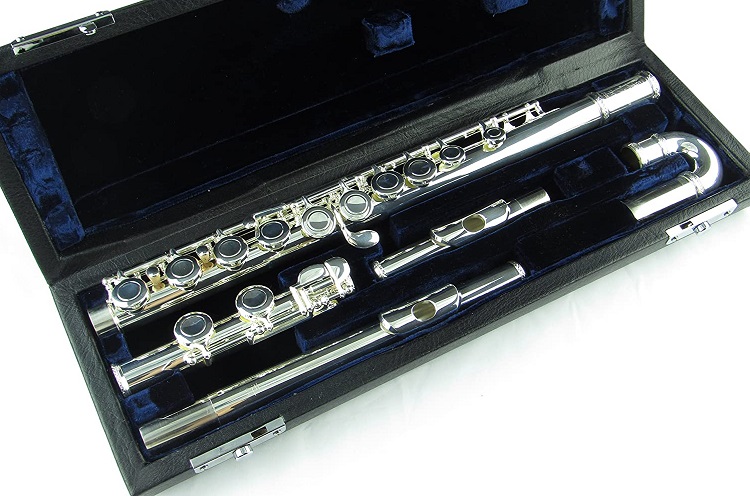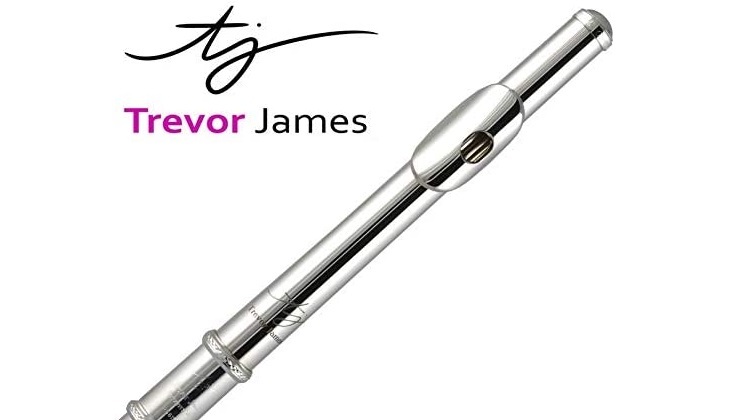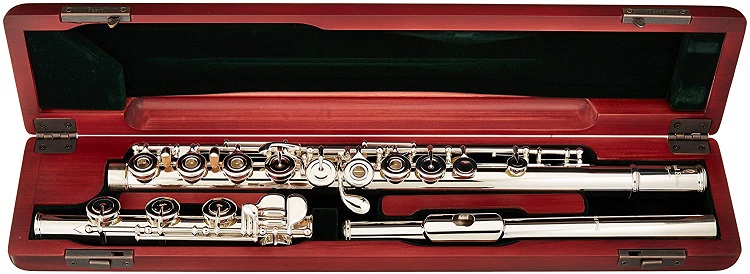- How to Find the Best Sopranino Saxophone - May 31, 2022
- How to Find the Best Contrabass Saxophone - May 30, 2022
- Trumpet Range Guide: Understanding The Entire Trumpet Range - May 19, 2022
Sir James Galway plays a gold flute, but that doesn’t mean you should, too. Instead, you need to know how to find the best C flute for you and your playing.
Sure, a gold flute might be perfect for you, but it might restrict your sound. Be sure to try flutes of all different brands and materials to help choose your next flute.
How to Find the Best C Flute
As a beginner or even a professional musician, you should know how to find the best C flute for your needs. Selecting your perfect instrument can make a significant difference in your playing and learning.
For better or worse, there are dozens, if not hundreds, of flutes available on the market. Because of that, you can find a flute that works for you, but you need to know how to narrow your search.
Here are some of my best tips for how you can find your next C flute.
Start with Your Level
The best flute for a professional isn’t the best for a beginner or vice versa. So think about your current level as a flute player to help find a model with the features you need.
If you’ve never played the flute, you should start with a student instrument. As you advance and start to feel like you’re outgrowing your current flute, you can plan on an upgrade.
Knowing your current level can help you eliminate flutes that won’t meet your needs. Then, you can keep from wasting your time and money on a flute you won’t like.
Assess Your Current Flute
If you already own a flute, take a look at it. Consider the level and specs of the flute as well as your level when you bought the instrument.
You can also look at the brand to help find a more advanced model from the same company. If you like your current flute, sticking with the same brand may be smart.
Or you might find that you want to avoid your current brand if you don’t like your flute. Either way, knowing what flute you have can help you upgrade to the best flute for you.
Research Flute Specs
Whether you have a flute or not, you should know some of the most standard flute specs. Consider the following features you can choose from:
- Open or closed holes
- C or B footjoint
- Offset or inline G
You can also look for flutes with a split E mechanism or a C# trill key to make certain notes easier to play. Some flutes also have a D# roller, which can help you play low notes with your right hand pinky.
Another thing to consider is the material you want, such as silver plating, solid silver, or even gold. As you advance as a flute player, you’ll have access to more flutes with different specs to help you customize the instrument to meet your needs.
Determine Your Budget
After you figure out what level of flute you need and what specs you want, it’s time to set aside some money. You can find flutes for as little as $100 or as much as $84,000.
Luckily, you don’t need to spend tons of money to get a good instrument, especially as a beginner. Student flutes are usually less than $1,000, while intermediate models range from $1,000 to $4,000.
Professional flutes tend to cost a lot more. Before you upgrade to that level, you should have enough playing experience to know that you’ll play the flute for a long time to make the cost worth it.
Consider Buying Used
If you have a small budget but need to upgrade your flute, look at used models. You can find listings on personal marketplaces, such as Facebook.
However, some music stores will sell used flutes on consignment for their clients. No matter how you find the flute, buying it used can be an excellent way to save money.
Except for the very high-end models, flutes don’t always hold their value. That means you could find a flute in like-new condition but for a fraction of the price.
Get Recommendations
With all of the flutes available, it can help to ask someone who knows you for recommendations. If you take flute lessons, your teacher should know your playing well enough to suggest certain brands or models.
Even other flute players you know that aren’t teachers can give their recommendations. Then, you will have a list you can use to start shopping for your next flute.
However, recommendations aren’t always going to lead you to the best model. Flutists may recommend the instruments they play and love, but those flutes might not work as well for you.
Try Flutes
If at all possible, you should try a bunch of flutes yourself before you choose one to buy. That way, you can feel and hear how the instrument responds when you play it.
To try multiple flutes at once, go to a local music store or order a flute trial from an online store. You can also visit a flute festival or convention near you to try flutes from all different companies.
I bought my intermediate flute after trialing multiple brands in one session. And when it came time to get my professional flute, I went to the National Flute Association Convention and found my current instrument.
Keep It Simple
When trying flutes, it can be hard to differentiate them and decide which you like best. And if you play unique music on each flute, you can muddy those differences even more.
So keep it simple and play the same things on all of the flutes you try. This will give you a chance to compare the instruments rather than the music.
You can play music that covers the written range, dynamic range, and various tempos. That way, you’ll also be able to figure out which model responds the best for you in different scenarios.
Trust Yourself
If you spend a lot of time shopping for a flute, the whole process might overwhelm you. But try not to overcomplicate or overanalyze all of the instruments you try.
Harry Potter was a huge thing when I was growing up, and it’s still popular. If you know much about the franchise, you’ve probably heard that the wand chooses the wizard.
Well, when it comes to choosing a flute, the same thing applies. Sometimes, you’ll play a flute, and you’ll just know it’s for you. So trust yourself, even if the flute isn’t one that others recommended.
Keep Trying
Sadly, you may not find your perfect flute the first time you shop for one. If that happens, keep looking for flutes, and don’t settle on one that you don’t absolutely love.
You may be able to settle for a flute as a beginner. But as you advance, you need an instrument that works with you and your playing.
If you settle, you might struggle to get a good sound. It would be better to stick with what you currently have and to shop around than to force a new flute to work.
Best Flutes for Beginning and Intermediate Players
As a beginner or intermediate flute player, you need an instrument that will support you. That way, you will be able to learn how to play the flute more easily.
Beginner flutes tend to be simple, so they can help you get a sound out of the instrument. Intermediate models form a bridge between student models and professional flutes, so they have more features but are still good for learning.
To help choose these flutes, I looked for reputable brands. I also considered if the flutes offered any unique specs that could help certain players. Here are some of the best flutes to consider as you learn the instrument.
Yamaha YFL-222
Yamaha is one of the most reputable musical instrument brands. The Yamaha YFL-222 is the entry-level flute, and it comes with many standard beginner specs.
It features a silver-plated headjoint and body, and there are closed holes to help you play with a less-than-perfect finger position. The low C footjoint keeps the flute from being too heavy, while the offset G is ergonomic for your left hand.
You can play this flute for a long time, and it can take a beating. That makes it great for students who need to practice in different places and who maybe aren’t the most careful when holding the flute.
Pros
- Great specs
- Durable
- Affordable
Cons
- Can be hard to avoid fakes
Yamaha YFL-462
The Yamaha YFL-462 is an intermediate version of the previous model. It features open holes and a solid silver headjoint and body, but the mechanism is silver-plated.
This model also has a gold lip plate, which provides a warmer sound. The gold can also be good for people who are sensitive to silver or nickel because your lips won’t contact those metals.
At this level, you will get a low B footjoint, so you can play more low notes. Pointed key arms make the instrument look professional, and you can use this instrument for years.
Pros
- Excellent features
- Durable
- Great for people sensitive to silver or nickel
Cons
- A bit expensive
Di Zhao 200
The Di Zhao 200 is an excellent beginner model, especially for anyone on a budget. It has the standard silver-plated headjoint and body that you find on other student instruments.
However, the riser and lip plate are solid silver, which can help you get a warm tone. The closed holes are great because you don’t need to put your fingers over the holes to get the right note to play.
And the C footjoint keeps the instrument light and easy to hold. That way, you can learn the basics of the flute before you need to upgrade.
Pros
- Warm tone
- Easy to play
- Lightweight
Cons
- Not for advancing players
Di Zhao 700
If you liked the 200, you may want to upgrade to the Di Zhao 700. This model is solid silver with a silver-plated mechanism, and it has pointed key arms to help it look more advanced.
Open holes help you learn where to place your fingers, and they allow you to play certain extended techniques. But the offset G keeps you from having to reach super far with your left ring finger.
Like other intermediate models, this one features a low B footjoint. And while it’s not the most affordable, it’s a good value for what you get.
Pros
- Suitable upgrade
- Good features
- Ergonomic
Cons
- Not a ton of extra keys or features
Trevor James 10X
I own the Trevor James 10X and currently use it as a backup flute. But as a beginner, it was an excellent instrument to help me learn the fundamentals of playing the flute.
This flute is perfect for smaller players because you can use it with a straight or curved headjoint. The body stays the same, but the curve brings the instrument closer to you so that you don’t have to reach as far.
Along with that, you get the same standard features as other beginner models. Plus, it comes in a case with a zipper, so you don’t have to deal with a latch that isn’t super secure.
Pros
- Great for players of all ages
- Easy to play
- Can last a long time
Cons
- A bit expensive for beginners
Trevor James Cantabile
If you’re ready for an upgrade but can’t afford to spend a ton, the Trevor James Cantabile might be for you. Unlike the other intermediate models I’ve shared, this one has a silver-plated body.
Since only the headjoint is solid silver, it costs a lot less than similar flutes. But you still get a lot of the same features, such as open holes and a low B footjoint.
The offset G key makes it easy for you to reach the key with your left hand. And you can use this flute for a long time, especially if you don’t plan to get a professional model.
Pros
- Great features
- Affordable
- Easy to play
Cons
- Not as much solid silver as some flutes
Pearl 505
The Pearl 505 is an excellent beginner model for students who want a bit more out of their flute. It has a lot of the same features you’ll find on intermediate models.
But with a silver-plated headjoint and body, you can cut down on the overall cost. You’ll still get open holes and a low B footjoint, so you can use this flute for a long time as you learn to play.
If you know you want to play techniques like microtones, getting a flute with open holes as a beginner can be great. The holes can also help you learn proper hand position right from the start.
Pros
- More advanced than some flutes
- Good features
- Suitable for beginners and as an upgrade
Cons
- Not the most affordable
Pearl 795
When you’re ready to upgrade, you should try the Pearl 795. This intermediate flute has the same standard specs as comparable models, including open holes, an offset G key, and a low B footjoint.
It also has a split E mechanism, which can help you play the third octave E. If you tend to struggle with that note, you may find that this flute makes it a lot easier.
This flute comes in a durable case and cover, so you can protect your investment. And you can play it for a long time until you have the money for an upgrade.
Pros
- Great upgrade
- Useful features
- Comes with accessories
Cons
- A bit expensive
Best Flutes for Professionals
I would need to write a whole other article on the best flutes for professionals. There are so many brands that make professional-level flutes. But the flute you choose at this level is so subjective.
For example, I play a Pearl Cantabile, but I know people who play tons of other models. Some brands to consider when shopping for a professional flute include:
- Altus
- Brannen
- Burkart
- Di Zhao
- Haynes
- Miyazawa
- Muramatsu
- Nagahara
- Pearl
- Powell
- Sankyo
- Yamaha
All of those brands offer at least a couple of professional flutes. Be sure to try as many of them as you can to figure out which professional flute suits your needs.
You can go to a music store or a flute convention to try them in person. Or you can order a few at a time to try the instruments at home. Either way, make sure you can try a flute before you commit to spending thousands on it.
FAQs About How to Find the Best C Flute
Answer: A C flute is another name for the western concert flute, silver flute, or flute. Those names all refer to the same instrument, and it’s the one you see in the front row of a concert band or in the middle of an orchestra.
The name comes from the fact that the flute is in the key of C, which is concert pitch. It doesn’t matter if the flute has a C or B footjoint, though, the name and transposition will stay the same.
Answer: Flutes are expensive because it takes a lot of time and work to create a good-quality flute. You need to put together a lot of small parts and fit them perfectly so that keys open and close as they should.
When it comes to intermediate and professional models, the metal can also affect the cost. Silver, gold, and platinum flute parts can drive up the cost of the instrument.
Answer: It can seem like starting on a professional flute would be good since the flute itself is better. But makers design professional flutes to meet the needs of more experienced players.
Flute companies design beginner flutes specifically for new players. They’re going to be easier to play when you don’t have much experience, so you can learn more quickly.
Answer: The best flute brand can be very subjective, so it depends on you and your preferences. You might prefer one brand, while someone else doesn’t like the brand you do.
In general, I’ve found that players tend to prefer American brands or Japanese brands. So if you like Yamaha, you may prefer a Sankyo or Altus flute over a Brannen or Burkart. But that “rule” might not apply to you.
Answer: You can stick to one brand as you upgrade to an intermediate or pro flute, but you don’t have to. I bought a different brand at each level, and I love all of my flutes.
If you stick with one brand, you might limit your options, and you could miss out on your perfect flute. So consider flutes from the same brand, but don’t ignore other models.
Final Note on How to Find the Best C Flute
Understanding how to find the best C flute can make a massive difference in your playing. If you have a flute that doesn’t work for you, you might have to struggle to play it.
So be sure to consider flutes from as many brands as possible, such as Yamaha and Pearl. Then, you can find a flute that will make you sound good and encourage you to keep practicing.
Looking for more interesting readings? Check out:


